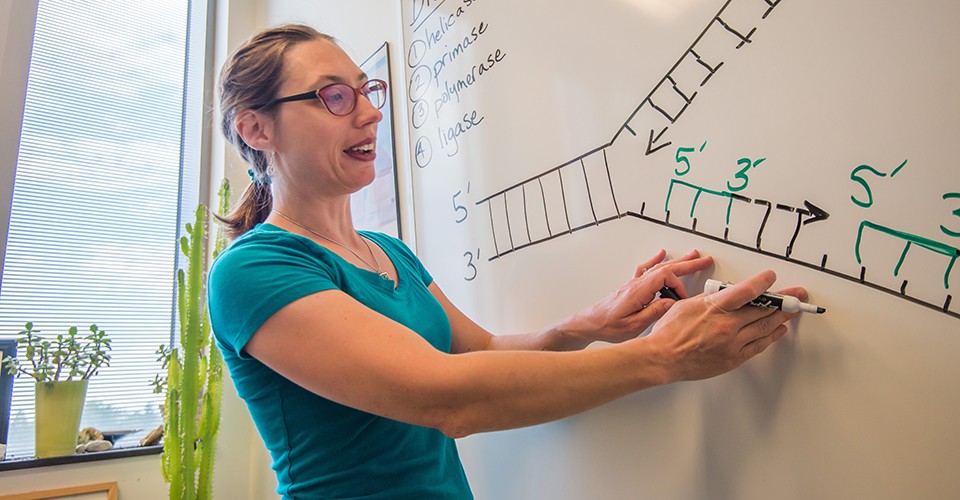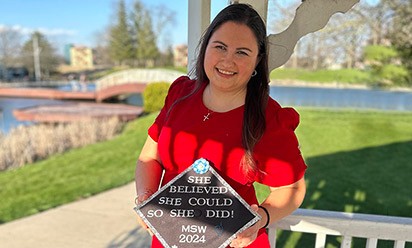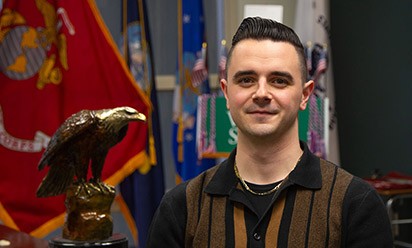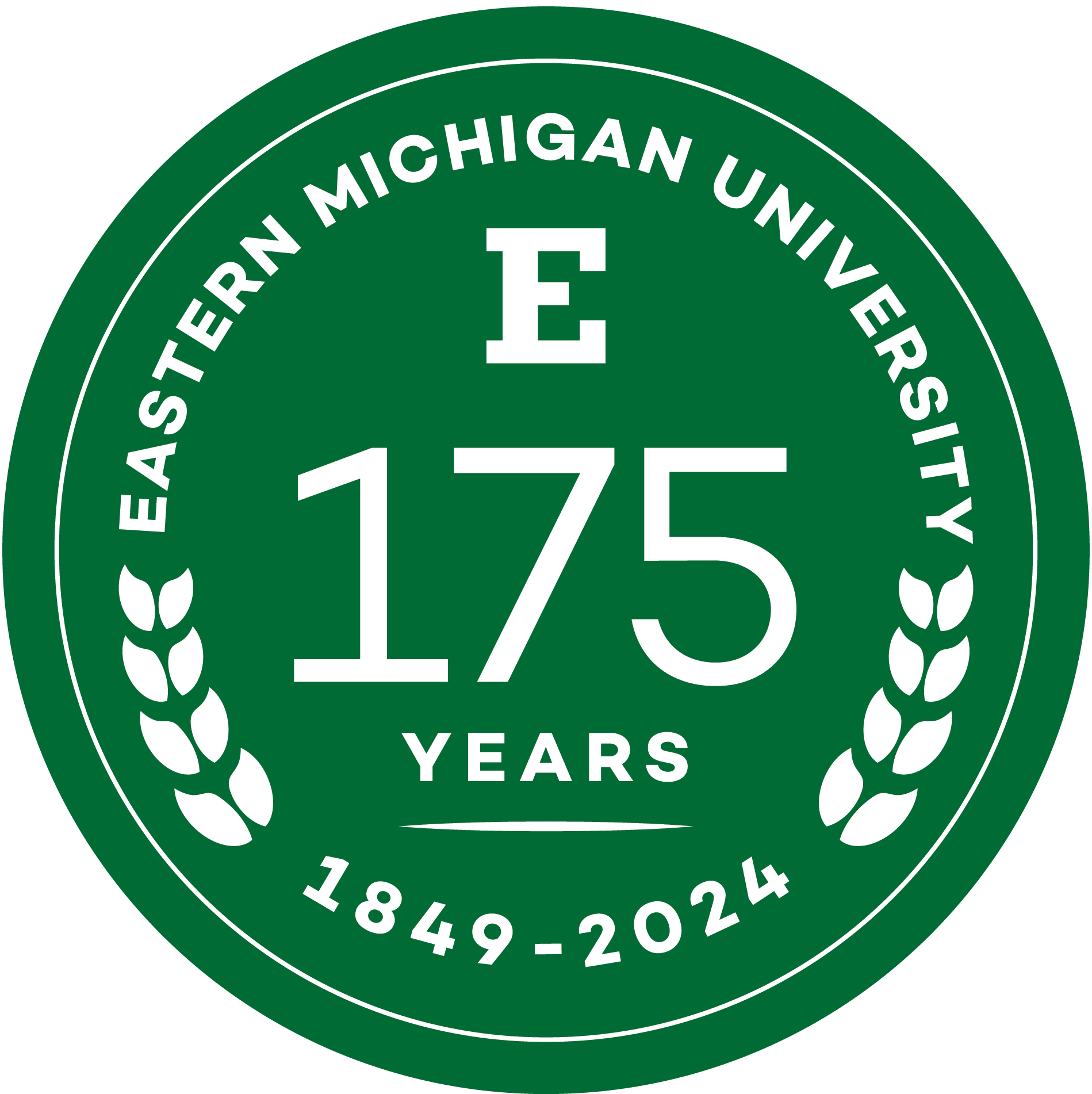Persistence pays: Eastern Michigan University biology professor Anne Casper devises classroom formula that increases student success
Pre-class videos detailing key elements of that day’s lesson combine with active in-class learning to produce striking results

YPSILANTI – It’s one of professor Anne Casper’s favorite academic scenes – students in the Mark Jefferson Science Complex Building staring intently into their smartphones in the days prior to one of her Introduction to Biology (BIO 110) class sessions.
No, they’re not building their social network, texting or checking Twitter. The students are viewing a 15-minute, pre-class lesson video, a crucial part of a curriculum Casper designed that has significantly improved the success rate in her class, particularly among disadvantaged students.
The results are documented in an article entitled, “True Grit: Passion and Persistence make an innovative course design work” in the latest edition of PLOS Biology, a leading national journal that publishes articles of high significance in the field of biology.
The piece notes how, after two unsuccessful tries, Casper adapted a highly structured course model that improved performance across the board and reduced the achievement gap that can affect certain students under a traditional lecture format.
Reducing inherent inequalities in preparation
The successful class design includes pre-class preparation videos, intensive active learning in class and weekly practice exams. And despite such a workload, students reported that total study time decreased.
“Faculty who have the grit to experiment and persevere in making evidence-driven changes to their teaching can reduce the inequalities induced by economic and educational disadvantage,” Casper says in her paper.
Such success didn’t come automatically when Casper set out to improve academic outcomes in 2012. That year, she cold emailed Scott Freeman, a professor at the University of Washington who had experienced strong gains in his introductory biology classes through retooling his teaching methods.
Freeman, who along with colleague Sarah Eddy co-authored the PLOS piece, was more than glad to help, and Casper soon visited his classes to get a first-hand look at how such an approach can succeed.
But it didn’t initially for Casper, who implemented several changes that yielded no improvement, such as substituting a weekly homework assignment of 30 questions with an online practice exam or having students do a high level of pre-class reading and question answering.
In her third try, Casper hit upon the videos, each of which takes about four hours to prepare.
“With the videos, I’m saying, ‘Give me 15 minutes of your life before you get to class,’” Casper says. In that time, the students also get 15 questions related to the video, of which just two will be posed in a short, three-minute quiz that begins each class.
Videos offer a powerful learning experience
In detailing the success of her third try, Casper notes a key distinction – that in today’s learning environment, many students enjoy and process the video information more deeply than reading from the textbook.
“The passing rate of students in the third semester was 20 percentage points higher than past semesters,” Casper says. “Many more students now have the opportunity to continue their studies in biology.”
Casper is also noted for her research on genetic change in cancer cells, for which she’s received several major federal grants, and for her work in the lab with her student assistants, whom she calls “labbies.”
She graduated with a bachelor’s in biology at the University of Nebraska in 1999, and then earned her master’s and Ph.D. at the University of Michigan. She joined the faculty at Eastern Michigan in 2009.
Casper says she loves working at Eastern Michigan, which offers the opportunity to blend teaching and connecting with students in her research.
“It’s exactly the kind of job I wanted,” Casper says. “I really wanted teaching to be a major part of my work along with research, and Eastern offers the ideal split.”
About Eastern Michigan University
Founded in 1849, Eastern is the second oldest public university in Michigan. It currently serves more than 18,000 students pursuing undergraduate, graduate, specialist, doctoral and certificate degrees in the arts, sciences and professions. In all, more than 300 majors, minors and concentrations are delivered through the University's Colleges of Arts and Sciences; Business; Education; Engineering and Technology; Health and Human Services; and, its graduate school. EMU is regularly recognized by national publications for its excellence, diversity, and commitment to applied education. For more information about Eastern Michigan University, visit the University's website.
More Stories

Eastern Michigan University awards Summer Research and Creative Activity Grants.

Eastern Michigan University to launch new Bachelor of Business Administration in Financial Planning and Wealth Management degree.

Eastern Michigan University empowers student-faculty collaboration with Undergraduate Symposium Research Fellow Awards.

Eastern Michigan University senior Raya Lasiewski inspires hope and healing through personal journey with eating disorder.

Veteran exceeds limits to becoming an Eastern Michigan University graduate.

